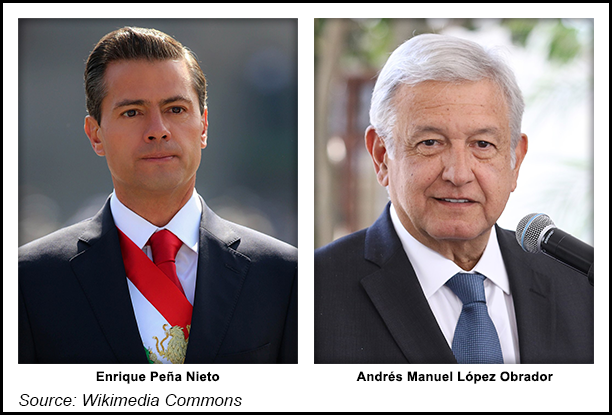Regulatory | NGI All News Access | NGI The Weekly Gas Market Report
Mexico’s Odd Couple Peña Nieto, López Obrador Preparing for Polite Hand Off
Seventy-three companies from 20 nations are exploring for oil and natural gas in Mexico, where every aspect of the hydrocarbons business, from upstream to retail, was a state monopoly until the 2013-14 nation’s energy reform, President Enrique Peña Nieto said this week in his sixth and last annual state of the nation address, known as the Informe.

Peña Nieto, the architect of the reform, justifiably accepted the credit for it as he presented the Informe to an invited audience.
Until recent years, Mexican presidents have presented their Informes to Congress, as most leaders do to their legislatures elsewhere in the world. With the birth of democracy at the turn of the century after seven decades of one-party rule in Mexico, a big change emerged in what was a semi-monarchic ritual.
In the former days of one-party rule, every one of what Peña Nieto had claimed were his successes was hailed by uproarious applause by legislators; every one of his quips was loudly guffawed. When a previous president spoke to the chamber, legislators and state governors scrambled to kiss his hand before he led a motorcade through the streets of the capital amid throngs of what some might have been considered to be a “rent-a-mob” of grateful citizens.
With that as the backdrop, it appeared to be inevitable that when democracy emerged, the opposite happened in cases where the bounds of common decency and respect were exceeded.
The result has been an Informe presented to a polite, invited audience. Congress occasionally has a raucous debate on the Informe, but without the presence of the president.
The hand-picked audience of Peña Nieto’s presentation could have included President-elect Andrés Manuel López Obrador. However, the incoming president, who takes office Dec. 1, chose not to attend.
That was a wise decision by López Obrador. His presence likely would have rained on Peña Nieto’s parade. Since his landslide election victory in July, López Obrador has captured all the media attention that once was held of Peña Nieto.
Like no previous Mexican president-elect, López Obrador has given the impression that he, not Peña Nieto, is already running the country, appointing future senior officials and dictating policy.
Meanwhile, Peña Nieto has taken a back seat.
Both men, however, are bent on effecting a smooth transition of power. During the Informe, Peña Nieto wished López Obrador goodwill for his future administration.
López Obrador, on a stopover in Monterrey, said he was deeply grateful that the country’s finances were stable, free from the threats of financial crises that have dogged several Mexican transitions of the past.
The two men are from very different backgrounds and with very different political influences. Nobody could ever have imagined them in their twilight years sharing a couple of beers in a country tavern. Nor would they ever want to do so. Both are products of a Mexican school of politics and could never be mistaken for a Mexican version of former President Clinton or France’s Francois Mitterrand.
Peña Nieto and López Obrador have, however, powerful interests in common. They face a five-month transitional period, the longest of its type in the world that could amount to a martyrdom, following the crushing defeat for Peña Nieto’s Partido Revolucionario Institucional (PRI) in the elections.
Peña Nieto seems desperate to preserve the legacy of his energy reform, which was all but forgotten during the election campaign. Nor have López Obrador’s proposals on energy convinced supporters so far of the reform.
However, López Obrador clearly may fear he is vulnerable because of his leftwing politics. Critics at home and abroad have branded him a clone of Venezuela strongman Hugo Chavez, who was president from 1999-2013. So far, however, the prophets of doom have been confounded.
The Informe showed that Peña Nieto’s six-year administration was marked by declines in production of oil and particularly natural gas, while imports of refined products and gas bloated the energy trade deficit. Gas imports averaged 5.15 Bcf/d in May.
Between the end of 2012 and the first half of this year, the national natural gas pipeline network added 3,815 kilometers (2,371 miles), one-third more than the end of November 2012.
In addition, the Nueces-Brownsville pipeline of the state power utility, sponsored by the Comision Federal de Electricidad (CFE), came on stream at the end last year to supply the undersea Sur de Texas-Tuxpan pipe now under construction.
Seven other gas pipelines now under construction are El Encino-Topolobampo, Tula-Villa de Reyes, La Laguna-Aguascalientes, Villa de Reyes-Aguascalientes-Guadalajara, Samalayuca-Sásabe, Tuxpan-Tula and Nueva Era. Together with Sur de Texas-Tuxpan, the new systems would add 3,706 kilometers (2,303 miles) and represent investments of just above $6 billion.
Mexico’s gas output, all but for a tiny fraction of it produced by the state-owned Petroleos Mexicanos (Pemex), closed the six-year administration at 4.761 Bcf/d. Meanwhile imports, almost all by pipeline from the United States, ran at about 9.5 Bcf/d.
The Sistema Nacional de Transporte de Gas Natural (Sistrangas), the national gas transmission system, is controlled by the Centro Nacional de Gas Natural (Cenagas) and transports about 6.3 Bcf/d, while the rest is moved by pipelines leveraged by CFE investments.
From September 2017 to June, crude oil production stood at 1.866 million b/d, down by 8.6% year/year. Output of natural gas was 11.8% over the same period.
Between the end of 2012 and the close of 2017, the nation’s hydrocarbon reserves fell from 13.9 billion boe to 8.5 billion boe.
The trade deficit on petroleum products from September 2016 to June 2017 registered $21.2 billion, a 38% increase because of substantial imports of gasoline particularly and from liquefied natural gas.
© 2024 Natural Gas Intelligence. All rights reserved.
ISSN © 2577-9877 | ISSN © 2577-9966 | ISSN © 1532-1266 |
